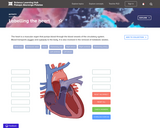
Students label parts of the human heart by dragging and dropping text labels onto a diagram.
- Subject:
- Science
- Material Type:
- Interactive
- Provider:
- Science Learning Hub
- Date Added:
- 03/09/2018

Students label parts of the human heart by dragging and dropping text labels onto a diagram.

Students use a rocket launch simulation. They change variables such as thrust to make a rocket go as high as possible.

In this activity, students will look at flowers and identify the different reproductive parts.

In this activity, students measure the pH of soil collected from a paddock (or other area). Then they will use a formula to estimate the amount of agricultural lime needed to promote good grass growth.

Students use water to explore its properties as a solid, liquid or gas.

Students use plasticine and sand to explore how adding other elements can alter the ductility of a metal.

Students will construct a simple anemometer.

Students will construct a simple barometer.

Students will construct a simple rain gauge.

Students will construct a simple thermometer.

Students will construct a simple weather vane and a simple compass.

Students use activity cards to match seeds with the fruits from which they grow. They learn that a seed will produce the same type of plant and seeds.

Students investigate the effect that contact with water has on melting ice.

Plastic bottles are used to simulate the link between land and sea. Students investigate some of the potential impacts increased nutrient use on land can have on the marine environment.

In this activity, students use observation to explore earthworm anatomy and the nature of science.

In this activity, students collect and observe macroinvertebrates from a local freshwater stream.

Students gather soil samples from their homes to view how soils differ from location to location.

Students observe how chicken eggs can be used to simulate the potential effects of increasing ocean acidity on marine animals with calcium carbonate shells or skeletons, for example, bryozoans and cockles.

In this activity, students take on the role of flower parts and act out the processes of insect pollination.

In this activity, students match native flowers with their pollinators, basing predictions on the main characteristics of flowers pollinated by wind, insects or birds. Students will understand how the structure of a flower is related to attracting pollinators.